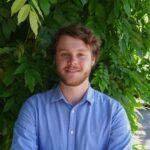The eco.business Fund, in partnership with FutureWater and Export Trading Group (ETG), one of the largest integrated agricultural supply chain managers and processors in sub-Saharan Africa, has launched a pilot project in Kenya for data-driven agricultural intensification. This project aims to improve farmer productivity and profitability whilst enhancing the environmental risk management and climate resilience of Kenya’s maize, coffee, and tea crops through improved soil and crop nutrition management. By using drones to monitor the application of these sustainable crop interventions from the selected farms, the project team will also be able to use the data to assess crop productivity improvements, create crop calendars to increase harvest yields, and understand land use changes to protect encroachment into biodiverse areas.
In Sub-Saharan Africa, population growth, associated food demand and pressure on natural areas have all increased greatly. Agricultural intensification – more production from the same acreage – remains a key solution to these challenges. One of the cornerstones of intensification is that of a higher and more productive use of inputs, such as fertilizer and water. So far, the average production has remained low and a significant yield gap still exists, mainly among small scale producers (SSPs). The limiting factors are (partly) caused by weather and climatic changes but also by a lack of agronomical knowledge, proper inputs, fertilizers and (climate smart) irrigation techniques. Thanks to the digital revolution Africa is going through, many commercial farmers already have access to a wide range of agricultural services. However, such solutions are not yet accessible to SSPs due to their costs.
A consortium led by FutureWater will collaborate with ETG agronomists and the Empowering Farmers Foundation (EFF) to work together with 60 selected maize, coffee, and tea farmers from around the country to implement Climate Smart Agricultural practices, such as crop rotation to rejuvenate soil nutrients, or mulching to reduce weeds and water erosion. By using drones to monitor the application of these sustainable crop interventions from the selected farms, the project team will also be able to use the data to assess crop productivity improvements, create crop calendars to increase harvest yields, and understand land use changes to protect encroachment into biodiverse areas. Soil samples will also be collected and analyzed to identify soil nutrition deficiencies and design appropriate soil enhancement measures that will be implemented on demo farms. The success of this pilot project will provide learnings on how it can be scaled up to reach more farmers and assess its replicability across different geographic locations.
Over the past years FutureWater and HiView managed to develop a low-cost agricultural drone technology which revolutionized the applicability of geo-information services for African farmers: ThirdEye. With the flying sensor service successful local enterprises were established that provide a low-cost drone service to small- and largescale farmers, both in Mozambique and Kenya. ThirdEye’s young agronomist-drone operators support farm decisions based on the flying sensor crop mapping that is viewed on a tablet. Integrating crop nutrition advisory and other improved agronomic practices into the ThirdEye service will bring the (extension) service up to the next level. In this project, we complement the work of flying sensors by ThirdEye with the agronomic service model of Holland Greentech including input distribution, demonstrations and field days, farmer training and coaching and soil testing.
By merging agronomic advisory services making use of low-cost flying sensors, soil testing, climate smart inputs, farmer coaching and an interactive online planning & monitoring portal, the farmer is able to improve his/her:
- Planning: What crop to grow in the season based on expected weather, crop prices and market demand;
- Cropping: When to sow the seed based on the type of crop and predicted weather
- Management: When and where to irrigate, fertilize and apply pesticide. This can help reduce the amount of inputs used in the farm and increase yields, thus helping with profitability.
- Harvest: When to harvest the crop based on market prices and predicted weather.
- Market linkage: The ability to make informed decisions on where to sell their produce, which may increase their income.
- Climate resilience: Option to order climate smart inputs and technologies from different suppliers. These technologies include hybrid seeds, propagation units and greenhouses, (drip) irrigation equipment, soil analysis, biological soil enhancers and biological pest control products.
This project is a collaboration between ETG Kenya, Empowering Farmers Foundation, Eco-Business II Sub-Fund Development Facility, HiView, FutureWater, Holland Greentech and ThirdEye Kenya. For more information visit: https://www.ecobusiness.fund/
Publicaciones relacionadas
2023 - Technical Report
HiFarm Synthesis Report
de Klerk, M., J. van Til, M. Hermus, N. Oranyo, K. Julius
2022 - Technical Report
HiFarm: Final Project Meetings Report
van Til, J., M. de Klerk
2022 - Technical Report
HiFarm: Nutritional Analyses
Hermus, M.
2022 - Technical Report
HiFarm: Agricultural Productivity Analysis
Schults, T., M. de Klerk
2022 - Technical Report
HiFarm Quarterly Report 4
de Klerk, M., J. van Til, M. Hermus, N. Oranyo, K. Julius
2022 - Technical Report
HiFarm: Cost Benefit Analysis
de Klerk, M.
2022 - Technical Report
HiFarm Quarterly Report 3
de Klerk, M., V. Hollander, J. van Til, M. Hermus, K. Julius, N. Oranyo
2022 - Technical Manual
Training Manual for HiFarm Project
de Klerk, M., M. Hermus, N. Oranyo, K. Julius, J. van Til
2022 - Technical Report
HiFarm: Knowledge exchange for lead farmers in Embu, Kenya
Hermus, M., N. Oranyo, M. de Klerk,
2022 - Technical Report
HiFarm Quarterly Report 2
de Klerk, M., V. Hollander, J. van Til, M. Hermus, K. Julius, N. Oranyo
2022 - Technical Report
HiFarm: Knowledge Exchange for Lead Farmers in Nakuru, Kenya
Hermus, M., N. Oranyo, M. de Klerk
2021 - Technical Report
HiFarm Quarterly Report 1
de Klerk, M., V. Hollander, J. van Til, M. Hermus, B. de Vries, N. Oranyo, K. Julius
2021 - Technical Report
HiFarm: Initial Scoping Report
de Klerk, M., V. Hollander, J. van Til, M. Hermus, B. de Bries, N. Oranyo, K. Julius




